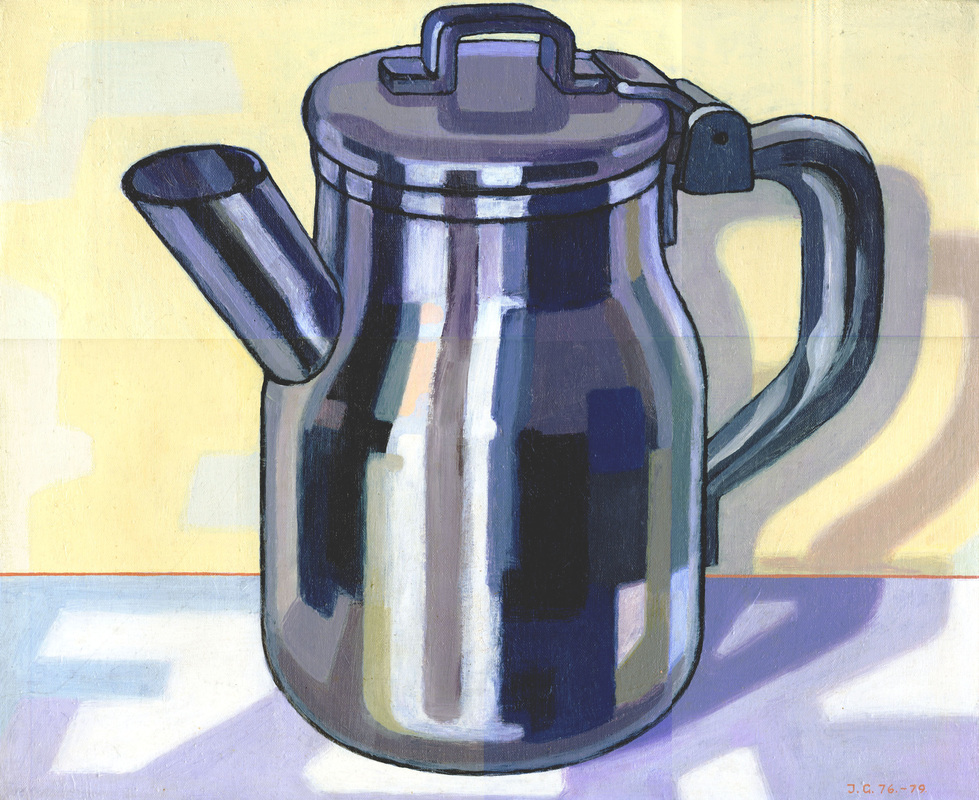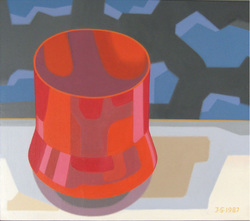|
During the past several weeks, Johannes gave detailed descriptions of Basic Design courses. Here, after some final thoughts, the essay returns to philosophical topics - aesthetics. (NINTH of eleven sections) I. Basic Design within the Foundation Program Within the Foundation Program the two semesters of Basic Design are by themselves a compact summary of an artist’s purely visual work of form and color, as opposed to figure or landscape drawing. Apart from the special mission of three-dimensional composing, the Surface Designs divide the language of their visual domains very carefully into the parts of art and gradually join them toward a plane of competence where the student will be no longer a beginner. To summarize the tasks of a two-semester Basic Design course: Basic Design I:
J. Historical Study 1. Artists need a grounding in Art History to see how cultural excellence – due to causes that fundamentally can never vary – appears in every period and all kinds of places.
2. Besides needing the History of Art to train their eyes at discerning other workers’ best creations – regardless of how unfamiliar may be the face they wear – artists want this study, as every man must want the history of his own kind, for the assuring companionship it offers.
There is no time for me to treat in our framework any useful portion of the History of Art. But we can deal here with the major steps in the development of Western Writing, whose dual heights of excellence must substitute for the miraculous abundance of the history of art which, alas, at present, poses an unwieldy horn of plenty. 1. Our Alphabet is the lineal descendant of Phoenician characters, which are thought to go back to Egyptian pictographs, or to have been independently contrived in Phoenicia. Aleph the bull became Alpha and “A,” Beth – the house, Beta and “B,” Gimel – the camel, Gamma and “G,” so that our word “Alphabet” itself is of this North Semitic origin. 2. Pictographs are unevenly exact sound-alikes. A picture of a deer could do duty for addressing some we are fond of, as in “my dear” and, less precisely, a “gull” as in seagull might mean a “girl.” When Aleph, Beth and Gimel turned into Hellenic Alpha, Beta, and Gamma, their names became mere pronunciation keys for the initial sound and the Phoenician meanings disappeared. Along the way the pictographs grew simpler and more geometric in design, and so became true letters. 3. Around 200 BC, ill-crafted linear letter skeletons, more of a Latin than of Greek appearance, assumed truly geometric character in the centered horizontal bar of “A” and the semi-circles of “C, D, S and R.” The geometric character since then has been preserved, but was modified correctively to give aesthetic satisfaction. These changes produced in A.D. 100 the Monumental Stone-Carved Roman Capital, with the thicks and thins, as well as serifs of our present day. 4. The monumental Roman Capital is the first of two lettering masterpieces we have in Western Europe.
5. I am indebted here a second time to John Howard Benson – who was the greatest writing master this country ever had – for my brief history of lettering. In his understanding, Chancery Cursive is the finest possible compromise between the needs of the reading eye and our rapidly writing hand. 6. Should we venture, perhaps rashly, to design an alphabet of our own, we must consider this historic line in order to remain inside the bounds of legibility.
If we paint and draw still lifes, landscapes, or the human face and figure and think that lettering can teach us nothing, then we are not true students of the arts we practice. For an excellence a little off-side of our personal striving allows us to dismiss for a while our own designs and can refresh our fatigued and clouded minds, thus crystallizing our judgment and brightening our vision. To perceive in other disciplines how he may improve within his own, characterizes the ardent student and true learner. III The Likeness of a Beautiful Thing A. Two Questions You owe this portion of the series to a one-time student who wrote me letters with questions about art to which I replied in essay form. One exchange dealt with the theme: “Why do we make art?” Two questions reside within the one:
Both of these are philosophical concerns, and a philosophic bent of mind will help us to consider them. But philosophic learning all alone cannot succeed, because the task requires also the experience of a working artist. Because of this, my discourse will not be exclusively a set of philosophical reflections, nor center only on artistic action. But, giving both their due, we may achieve right understanding and thus reveal most clearly what an artist will find proper and worthwhile to do. B. The Meaning of the Term “Art” Art is a strange word, not for what it means, but what it fails to mean.
In the great puzzles of existence, groping in the dark may be common in Philosophy. But otherwise, so much groping in the dark is not altogether usual, because language strives for our understanding, and not to deepen the confusion. For example, “lawnmower” and “dishwasher” proclaim at once what these appliances are and the service they deliver. My task is to make as precisely clear what art is and it does for us, as the names lawnmower and dishwasher make clear the function of those objects. To make as clear, however, does not mean to state as briefly. On the contrary, I must, to some degree, become substantially long-winded. C. The Claim Implied through Showing Art
rich reward.
Comment:
Has some other discipline offered you insight into the practice or appreciation of visual art?
0 Comments
In the early 1990s this was given first as a speech to a class at the Lancaster County Art Association, and in briefer form afterwards on a couple of other occasions. Some of the illustrations come from the text, others from references to physical works that Johannes brought with him, and one from live demonstration. (FIRST of eleven sections) I The Artifact and the Art Object A. Rules for Right Making in Utility and Art In past times distinctions were drawn between products of the Fine Arts and humble Objects of Utility, adding to the latter ever the inferior rank. Much thinking in this century turned this around, proclaiming the well-made artifact the equal of the work of art and, in all essential ways, indistinguishable from it. The difficulty may not be amenable to any final settlement. There is a common good desired of them both: We want our furnishings as well as our pictures to be beautiful. But their capabilities and purposes can also differ widely; and that needs to be accounted for before this search for understanding ends. Yet, for our start it will be helpful that the ground rules for creating a good product govern equally the object of utility and one existing solely for its beauty – the Applied as well as the Fine Arts. B. John Benson’s Course and the Twin Purposes of All Instruction Undergraduates at Rhode Island School of Design in the 1950s studied during one semester a subject called Philosophy of Design. The course was taught by a great man, John Howard Benson. It was beautifully organized, and ably introduced us to a domain of intellectual concern that few artists ever get to know. Also, it fulfilled better than most others the twin purposes of all instruction:
C. Ways of Delivering the Wrong Results When an otter lies upon its back and opens a mussel by breaking the casing with a stone, or a raptor rises to some height and drops its catch to shatter on the ground below, or again, an early hominid seized a rock to cleave with it the brain-case of his game, the deeds appear identical in their complexity of mental action. But they are most dissimilar in their cultural and, in the end, historic consequences. Man alone evolved to overcome, to an extent, the specific limits all other species failed to breach. These, however, remain the causes of inferior work at the hands of man, to the present day. They are:
D. The Worthwhile and Essential Callings of Man’s Life
E. The Causes of Things Made There are reasons, or causes, why Man-Made Things Exist
and of the materials to each other. Techniques are the union of the Material and Efficient Causes. Materials properly chosen for their purpose are shaped according to what the right tools and materials can suitably be made, and want, to do for a desired end. 4. Formal Cause: The solution of the problem and its final form are achieved in Stages. The Stages are reductions, that is, Abstractions derived from the problem posted by the patron. Stages constitute the successive images to which the materials must by shaped. [Other Causes than those cited as Antecedents of Results –from notes at end of essay:
F. Stages as Instrumental Intermediate Forms
knowledge, will, and skill, but also inventive sensibility, is brought to bear to set the correct milestones in their places as the Work Path gradually unfolds. It is here, when we must rely on our uncertain intuitions, that we cannot altogether escape our own uneasiness of mind. 3. The last of the abstractions that we call a Stage is the Final Form and conclusion of the worker’s effort. It represents perfection as a thing complete and thoroughly constructed. Perfection is here not an attribute divine, but must be rightly understood as a property of man-made things within their range of possibilities, that is, within the impediments or limits of the job. When the last possible duty is faithfully performed, perfection as achieved because we can do no more – the final chore and last detail. Comment:
Perhaps you can comment from work you have done in Arts, Crafts or other projects using Stages as Intermediate Forms . . . . |
A Blog containing longer text selections from essays by Johannes, on art, philosophy, religion and the humanities, written during the course of a lifetime. Artists are not art historians. People who write are not all learned scholars. This can lead to “repeat originality” on most rare occasions. When we briefly share a pathway of inquiry with others, we sometimes also must share the same results.
Categories
All
Archives |
| von Gumppenberg | Johannes Writes |
|
|












 RSS Feed
RSS Feed